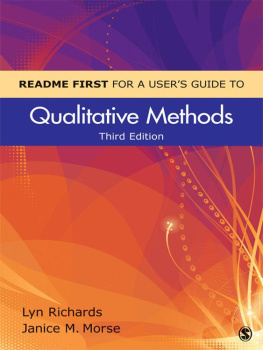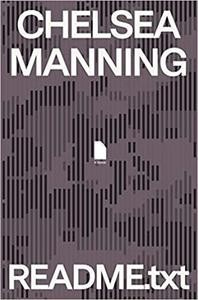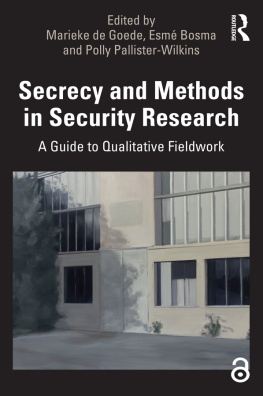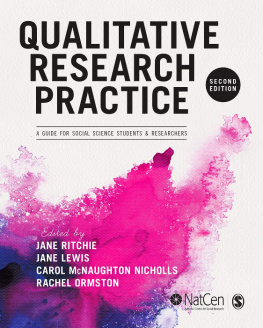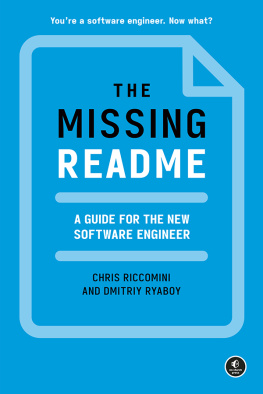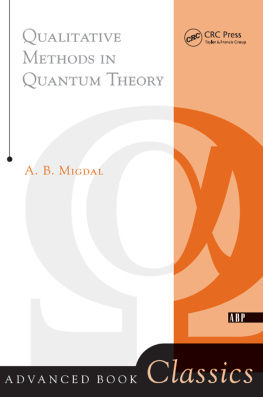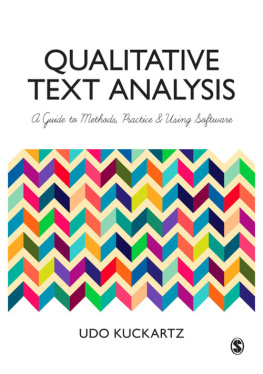Lyn Richards - README FIRST for a User′s Guide to Qualitative Methods
Here you can read online Lyn Richards - README FIRST for a User′s Guide to Qualitative Methods full text of the book (entire story) in english for free. Download pdf and epub, get meaning, cover and reviews about this ebook. year: 2012, publisher: SAGE Publications, genre: Politics. Description of the work, (preface) as well as reviews are available. Best literature library LitArk.com created for fans of good reading and offers a wide selection of genres:
Romance novel
Science fiction
Adventure
Detective
Science
History
Home and family
Prose
Art
Politics
Computer
Non-fiction
Religion
Business
Children
Humor
Choose a favorite category and find really read worthwhile books. Enjoy immersion in the world of imagination, feel the emotions of the characters or learn something new for yourself, make an fascinating discovery.
- Book:README FIRST for a User′s Guide to Qualitative Methods
- Author:
- Publisher:SAGE Publications
- Genre:
- Year:2012
- Rating:3 / 5
- Favourites:Add to favourites
- Your mark:
- 60
- 1
- 2
- 3
- 4
- 5
README FIRST for a User′s Guide to Qualitative Methods: summary, description and annotation
We offer to read an annotation, description, summary or preface (depends on what the author of the book "README FIRST for a User′s Guide to Qualitative Methods" wrote himself). If you haven't found the necessary information about the book — write in the comments, we will try to find it.
Lyn Richards: author's other books
Who wrote README FIRST for a User′s Guide to Qualitative Methods? Find out the surname, the name of the author of the book and a list of all author's works by series.
README FIRST for a User′s Guide to Qualitative Methods — read online for free the complete book (whole text) full work
Below is the text of the book, divided by pages. System saving the place of the last page read, allows you to conveniently read the book "README FIRST for a User′s Guide to Qualitative Methods" online for free, without having to search again every time where you left off. Put a bookmark, and you can go to the page where you finished reading at any time.
Font size:
Interval:
Bookmark:
README FIRST FOR A USERS GUIDE TO
Qualitative Methods
Third Edition
To our students, with thanks for all they have
taught us about the challenges of learning to work qualitatively.
README FIRST FOR A USERS GUIDE TO
Qualitative Methods
Third Edition
Lyn Richards
RMIT University
Janice M. Morse
University of Utah


FOR INFORMATION:
SAGE Publications, Inc.
2455 Teller Road
Thousand Oaks, California 91320
E-mail:
SAGE Publications Ltd.
1 Olivers Yard
55 City Road
London EC1Y 1SP
United Kingdom
SAGE Publications India Pvt. Ltd.
B 1/I 1 Mohan Cooperative Industrial Area
Mathura Road, New Delhi 110 044
India
SAGE Publications Asia-Pacific Pte. Ltd.
3 Church Street
#10-04 Samsung Hub
Singapore 049483
Acquisitions Editor: Vicki Knight
Associate Editor: Lauren Habib
Editorial Assistant: Kalie Koscielak
Production Editor: Laureen Gleason
Copy Editor: Megan Granger
Typesetter: C&M Digitals (P) Ltd.
Proofreader: Kate Macomber Stern
Indexer: Wendy Allex
Cover Designer: Garon Kiesel
Marketing Manager: Nicole Elliott
Permissions Editor: Adele Hutchinson
Copyright 2013 by SAGE Publications, Inc.
All rights reserved. No part of this book may be reproduced or utilized in any form or by any means, electronic or mechanical, including photocopying, recording, or by any information storage and retrieval system, without permission in writing from the publisher.
Printed in the United States of America
Library of Congress Cataloging-in-Publication Data
Richards, Lyn.
Readme first for a users guide to qualitative methods / Lyn Richards, Janice M. Morse. 3rd ed.
p. cm.
Includes bibliographical references and index.
ISBN 978-1-4129-9806-2 (pbk.)
1. Social sciencesResearchMethodology. 2. Qualitative research. I. Morse, Janice M. II. Title. III. Title: Read me first for a users guide to qualitative methods.
H62.M6612 2013
001.42dc23 2012001310
This book is printed on acid-free paper.
12 13 14 15 16 10 9 8 7 6 5 4 3 2 1
Appendix 1. Qualitative Software: Where to Go Next
by Lyn Richards
Appendix 2. Applying for Funding
by Janice M. Morse
Appendix 1. Qualitative Software: Where to Go Next
by Lyn Richards
Appendix 2. Applying for Funding
by Janice M. Morse
Q ualitative research is rapidly expanding, constantly changing, and becoming increasingly accepted in areas where, until very recently, it was derided. The problems we and our students faced a decade ago are quite different from the new challenges, yet much of the literature is unchanged. Where qualitative methods previously were a minority activity in most disciplines, learned as a craft in apprenticeship to experienced researchers, they are now often attempted without training, and researchers may have difficulty finding mentors. Where data handling was a gross clerical load and data access limited by human memory, computer software now provides ways of handling and analyzing data that were impossible to achieve by manual methods. The widespread use of specialist software has made qualitative research more attractive and more accessible to those without qualitative training. Just as a decade ago, however, it remains difficult to begin a qualitative project, make sense of methodological choices, and get thinkinglet alone startedon the right track. The researcher facing these difficulties is much more likely now to be facing them alone.
We wrote this book in recognition that these changes have altered the qualitative research world forever. Since the first edition, this book has been used by researchers at many levels of experience and translated into several languages. As change continued, we prepared a second and now a third revised edition reflecting on new pressures on researchers and new opportunities for them.
We share a conviction that if the changes are merely ignored or regretted, damage is done to both the researchers and the methods. New researchers need to get over those preliminary obstacles, to understand the language of qualitative inquiry, and to know what questions to ask, where to look for information, and how to start thinking qualitatively. They also need to challenge myths and false expectations and to know what to expect before they start the real thing. This involves placing the wonderful promises of qualitative research in the context of the methods that make them work, and facing up to the processes of choosing methods appropriate for your research. It also involves placing the promises of technology in the context of tasks and techniques.
This book is intended to be read first by those who are thinking about becoming qualitative researchersbefore they acquire data; before they preemptively choose a method, let alone a software package; and before they commit to a project. It may be used as a text for an introductory course, or it may be used by those who are simply interested in qualitative inquiry and want to get a feel for the qualitative research process. This new edition includes an overview of what software can now do for you. On our new companion website you will find advice on choosing software appropriate to your method and links to sites carrying up-to-date reviews of software and tutorials so that you may try out the computer tools and learn what they offerand what they dontbefore you propose your own project. Above all, the aim of this book is not to teach a single method but to map the range of methods, not to commit you to one sort of research but to show you why there are so many ways of working qualitatively. As we wrote these chapters, we discovered how different our own methods were. Readers who know our work will recognize one voice or another as that of the first author of particular chapters. But all our diverse experiences pointed to the same needa need for a book that would meet the approaching researcher at the beginning of the path into the methodological maze.
The idea for this book grew from our shared frustration with the resources to help novice researchers see into the fascinating jungle of qualitative methods, and find their way through it. It draws on our separate and different attempts to teach qualitative methods to students and professionals and to assist with their research. We thank our students, colleagues, and friends for their questions and challenges, for sharing their confusions and insights, and for providing opportunities to explain abstract and complicated concepts and techniques. We thank our husbands, Bob Morse and Tom Richards, for their support and assistance. At SAGE, thanks to our editor, Vicki Knight, for her enthusiastic help in making this edition happen and to the copy editor, Megan Granger, for her fine attention to its final details.
Lyn Richards & Janice Morse
SAGE and the authors gratefully acknowledge the contributions of the following reviewers: Rhonda R. Buckley, Texas Womans University; Matthew A. Eichler, Texas State UniversitySan Marcos; Sandra Mott, Boston College; Cheryl L. Nosek, Daemen College; Ruth Segal, Seton Hall University; Mona Shattell, DePaul University; and Irina L. G. Todorova, Northeastern University.
Lyn Richards, BA Hon. (political science), MA (sociology), is a qualitative research writer and consultant and adjunct professor in the Graduate School of Business at RMIT University in Melbourne. As a family sociologist, she published four books and many papers on Australian families and womens roles. As a methodologist, she taught graduate and undergraduate qualitative research at La Trobe University and went on to write for and teach the teachers. Her tenth book is
Next pageFont size:
Interval:
Bookmark:
Similar books «README FIRST for a User′s Guide to Qualitative Methods»
Look at similar books to README FIRST for a User′s Guide to Qualitative Methods. We have selected literature similar in name and meaning in the hope of providing readers with more options to find new, interesting, not yet read works.
Discussion, reviews of the book README FIRST for a User′s Guide to Qualitative Methods and just readers' own opinions. Leave your comments, write what you think about the work, its meaning or the main characters. Specify what exactly you liked and what you didn't like, and why you think so.

